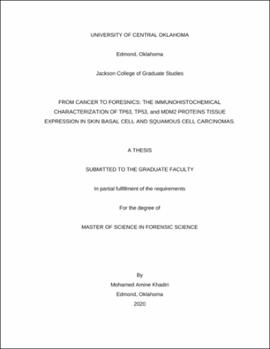| dc.description.abstract | Skin cancer is one of the most occurring cancers in the world and its occurrence is rising. Many factors contribute to the development of skin cancers such as UV light exposure, chronic inflammation, and genetic susceptibility. Cancers such as basal cell carcinomas and squamous cell carcinomas arise from cells within the epidermis. TP53 and TP63, members of the p53 protein family, play a major role in skin tumorigenesis and progression. While p53 is the most mutated gene in human cancers, p63 is seldom mutated in cancers. The functions of p53, “guardian of the genome”, have been well documented and studied. Nonetheless, many studies show that p63 is overexpressed in tumors. Other studies show that p63 is lost during tumorigenesis and cancer progression. Consequently, whether the p63 gene is a tumor suppressing gene or an oncogene remains a matter of the p63 protein’s isoforms present in these tumors and their interactions with p53 and MDM2. This challenge has two facets. First, the multiple spliced isoforms of p53 and p63 which have different functions in skin development as well as skin cancers. Second, the Mouse Double Minute 2 (MDM2) protein, a negative regulator of p53, which has been shown to have different proteomic affinities by which it binds these different p53 and p63 isoforms. The findings of this project are geared toward characterizing and semi-quantifying the histopathological expression of p63, p53 and MDM2 in cutaneous basal cell carcinomas as well as squamous cell carcinomas, while addressing the aggregation propensities between these proteins. The project also aims to summarize the forensic use of p53 and p63 as potential biomarkers for the estimation of age in antemortem and postmortem wounds and lesions. We have used advanced softwares such as ImageJ from the NIH and QuPath to extract important data to better characterize the layer-by-layer expression of p53, p63, and MDM2 in specific areas such as the epidermis, the dermal layer, stroma, and tumor nests. We used multiple skin tumor biopsies and excisions from three different skin cancer patients. The molecular simulations using the PASTA 2.0, AGGRESCAN, and FELLS webservers is to compare and contrast the aggregation propensities of p53 and p63 and what locations of their protein sequences are hot spots for aggregation. Results showed that p63 has the most stain intensity and was strictly nuclear in all three cases (p-value of 0.0007). The consistent expression of p63 in all three cases indicates the important role of p63 in the tumorigenesis of skin epithelial cells and dysplasia. MDM2 has been shown to have a strong stain intensity both nuclear and cytoplasmic in all three cases but was of no significance in differentiating our cases (p-value of 0.718). p53 was partially absent in all three cases and had a weak stain intensity when present (p-value of 0.086). Data from the FELLS, PASTA 2.0, and AGGRESCAN showed that p53 has the highest number of residues susceptible to aggregation at 27.48% (108 residues), whereas p63 and MDM2 have aggregation percentages of 7.94% (54 residues) and 3.67% (18 residues) respectively. Clinically, studies show that p63, particularly the ∆Np63 isoform, has an essential role in epithelial wound repair. Forensically, studies show that p53’s expression increased in wounds with an interval of post-infliction of three to 77 days. This makes p53 a potential candidate for wound age estimation in ante-mortem wounds with longer survival time after the injury. Research also shows that these later conclusions cannot be applied to postmortem wounds and that further research is needed to evaluate the potential use of p53 in a postmortem setting. | en_US |
